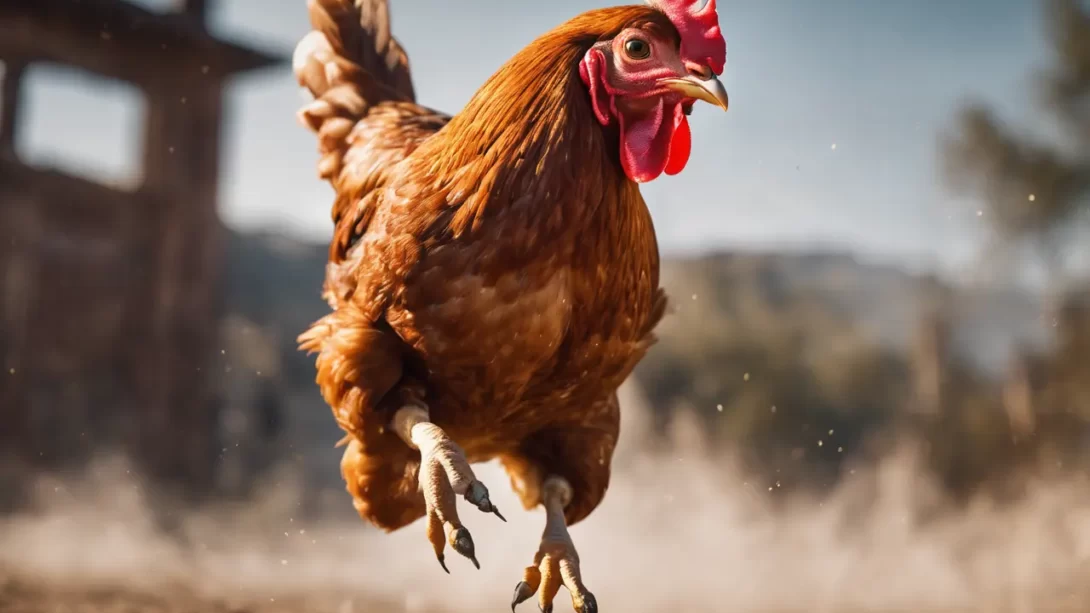Chickens, often seen pecking around peacefully in a backyard, possess a surprising level of physical capability, including the ability to jump. For backyard chicken keepers, understanding these abilities is crucial for designing safe and appropriate living spaces. This article explores the factors that influence how high chickens can jump and provides insights into their physical capabilities, ensuring that your feathered friends are both secure and happy.
Chicken Anatomy and Mobility
Chickens are endowed with a unique anatomy that facilitates their mobility, including their ability to jump. While they are not known for sustained flight, chickens have strong leg muscles and a lightweight bone structure, which aids in their jumping ability. The breed of the chicken plays a significant role in how agile or mobile it is. For instance, lighter breeds tend to be more adept at jumping and flying short distances compared to heavier breeds.
The age and health of a chicken also significantly impact its mobility. Younger chickens, being more energetic and lighter, can usually jump higher than older, heavier birds. Similarly, a healthy chicken with a balanced diet and adequate exercise will generally be more agile than one that is not well-cared for. Understanding these nuances is key for chicken owners to manage their flocks effectively.
Factors Influencing Jumping Ability in Chickens
Several factors contribute to the jumping ability of chickens. Breed and genetics are at the forefront, with some breeds inherently more capable of higher jumps. Bantams, for example, are known for their light weight and agility, making them skilled jumpers.
Age is another critical factor. Younger chickens are typically more energetic and capable of higher jumps than their older counterparts. As chickens age, their muscle strength and overall agility tend to decrease, reducing their jumping ability.
Health plays a pivotal role as well. A healthy chicken with proper nutrition and exercise is more likely to exhibit higher levels of physical activity, including jumping. Conversely, chickens with health issues or those that are overweight may struggle with jumping.
Environmental factors also influence a chicken’s propensity to jump. Chickens in spacious environments with opportunities to explore and exercise may develop stronger muscles, enhancing their ability to jump. Motivation is another aspect; chickens might attempt higher jumps if they are motivated by factors like escaping predators, reaching food sources, or exploring new areas.
Average Jumping Heights for Chickens
Understanding the average jumping heights for chickens can be crucial for effective coop and run design. Generally, chickens can jump between 4 to 6 feet high, but this range can vary significantly depending on the breed and individual bird. Lighter breeds, such as Leghorns or Bantams, are often capable of reaching heights at the higher end of this spectrum. In contrast, heavier breeds like Orpingtons or Wyandottes typically achieve lower heights due to their weight.
However, there are always exceptions, and some chickens may exhibit extraordinary jumping abilities. It’s not uncommon to hear anecdotes from chicken keepers about a particularly adventurous bird that defies the norms. These outliers highlight the importance of observing and understanding the specific capabilities of your chickens.
Designing Coops and Runs with Jumping in Mind
When designing a coop and run, it’s essential to consider the jumping abilities of your chickens to prevent escapes and ensure their safety. A general guideline is to have fences or barriers that are at least 6 to 8 feet high, especially if you have lighter, more agile breeds. This height is typically sufficient to deter most chickens from attempting to jump out.
In addition to height, the design of the coop and run should cater to the natural behaviors of chickens. Providing perches at different heights and areas for dust bathing and foraging can keep your chickens engaged and less inclined to jump out of their designated area. It’s also beneficial to ensure that the space is not overcrowded, as a cramped environment can lead to stress and encourage escape attempts.
Incorporating elements such as netting or roofing in parts of the run can offer additional security, particularly for those breeds known for their higher jumping capabilities. This approach not only prevents escapes but also protects chickens from aerial predators. When designing these spaces, however, it’s important to balance security with the welfare of the chickens, ensuring they have enough room to exhibit natural behaviors and live comfortably.
Training and Managing High-Jumping Chickens
For chicken keepers facing challenges with high-jumping breeds, training and management strategies can be effective. Training chickens to stay within their designated areas involves consistency and patience. One approach is to gently guide them back to their area whenever they jump out, reinforcing the boundaries. Over time, chickens can learn the limits of their space.
Managing adventurous chickens also involves proactive strategies to keep them safe and contained. This can include enriching their environment to reduce the desire to jump out. Adding elements like climbing structures, varied perches, and engaging toys can make the coop and run more stimulating, thereby reducing the chickens’ inclination to explore beyond their boundaries.
Wing clipping is another method used by some keepers to manage their chickens’ jumping and flying abilities. This process involves trimming the primary flight feathers of one wing to imbalance their flight, thus reducing their ability to jump high or fly. It’s important to note that wing clipping should be done carefully to avoid causing harm to the chicken, and it’s often recommended to seek advice from a poultry expert or veterinarian.
Conclusion
Understanding the jumping abilities of chickens is crucial for backyard chicken keepers. By recognizing the factors that influence how high chickens can jump, such as breed, age, health, and environment, keepers can create safer and more enjoyable spaces for their flocks. The average jumping height for chickens typically ranges between 4 to 6 feet, but individual abilities can vary.
Effective coop and run design, training, and management strategies are key to keeping high-jumping chickens safe and secure. This includes constructing appropriate barriers, enriching the living space, and considering techniques like wing clipping if necessary. Remember, each chicken has its unique personality and capabilities, so observing and adapting to your specific flock’s needs is essential.
Balancing the welfare of your chickens with effective management practices ensures a harmonious and thriving backyard flock. Continuous learning and adaptation are part of the rewarding journey of keeping chickens, contributing to a fulfilling experience for both the chickens and their keepers.




